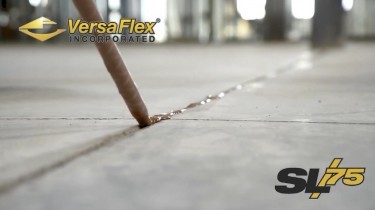NYC Sidewalk Joints : SL/60
MARKET: Joint Systems : Sidewalk Joints
SYSTEM: SL/60 Joint Filler
PROJECT: NYC Landmark : Sidewalk Joint Systems
OWNER: NYC Landmark Building
CONTRACTOR: MDB Dev
“We want the the best sidewalk joints in NYC.” These were the marching orders for the consulting firm and contractor handling the sidewalk repair and rehabilitation stage of this commercial building’s $550 million-plus total renovation.
The New York City landmark and one of the tallest buildings in the world has been completely overhauled with new windows, elevators, a new observatory, and LEED certification expected to reduce the skyscraper’s energy use by 38 percent a year by 2013, at an annual savings of $4.4 million. The total retrofit project aims to attract larger corporate occupants at higher price points.
But of course you can’t spend all that money, and do all that work, and attract higher paying tenants without fixing up the old busted up sidewalks.
Under normal conditions, repairing sidewalk concrete and filling the joints with polyurea joint sealant is a fairly routine operation. But when the project is integrated into a ½ billion dollar skyscraper renovation, the project is anything but routine.
The sidewalk repairs began around mid 2012 and took approximately 4-5 months to complete. During this time they encountered all sorts of unforeseen challenges and interruptions, yet with a coordinated approach by the consultant and strong support from the material supplier (VersaFlex) they were able to live up to the challenge and deliver some of the nicest sidewalks and joints in NYC.
The project consultant interfaced with the building owners and contractor to handle material selection, installation procedures and coordination with other trades during the sidewalk repairs and joint fill / sealant work.
The installation contractor first attacked the deteriorated sidewalk by conducting typical concrete repairs, fixing radius-ed edges with new saw-cuts, and cleaning and prepping the concrete for optimum performance and adhesion of the joint fill material.
The polyurea joint sealants were originally specified as an alternate at the outset of the the project. A significant amount of mock-up testing, including evaluation of adhesion to substrate and in-service stress (high heels), was conducted. The mock-up trials were essential in determining the most suitable sealant considering the existing substrate conditions (latent/patent moisture presence in concrete). In addition the trials had to resolve the owner’s aesthetic expectations, high pedestrian traffic activity, sealant cure period and related protection issues.
The consultant and contractor had to conduct numerous testing to assure the building owners got exactly what they wanted in terms of the finished product’s performance and aesthetics. During the mock-ups stages, a variety of elastomeric sealants were evaluated, tested and trialed including polyurethanes, silicones, polyethers and polyurea.
Ultimately, the polyurea joint sealants from Versaflex (SL/60) were selected because of their superior performance in the stress/peel testing and the fast cure nature of the polyurea vs the other traditional systems. In fact, under the construction restraints and weather/environmental circumstances facing the install, VersaFlex’s SL/60 polyurea joint sealants were the only material that would have worked.
Now comes the install. Since the contractor was not thoroughly familiar with the two-part polyurea systems, a great degree of on-the-job training had to occur. Being only familiar with single component polyurethane systems, there was a learning curve in the application technique and equipment the contractor had to overcome with using the two-component polyurea joint fill systems that were now specified.
The project consisted of sealing concrete and storefront joints in the sidewalk segments bordering 34th Street, 5th Ave, and 33rd Street. In order not to impede the pedestrian traffic in this highly popular area of New York City, the preparation and sealant application work had to be performed at night. Not only was this a large area, but they were restricted to performing the work only at night. This introduced logistical issues such a proper lighting, moisture and dew point issues, as well as sidewalk power washing, planter watering and vendors discharging used process water. The contractor split the task into joint cleaning and joint preparation/sealant application. The work was limited to each sidewalk section in order to be able to open the full sidewalk each day by 7 am for pedestrian traffic.
This high traffic flow was another reason the fast set VersaFlex SL/60 was required. Not only did it allow for rapid return to service, but no dirt, leaves or other construction debris was able to get stuck in the curing material.
To make things worse, window washing and daily watering of the plants that lined the sidewalk introduced more water and moisture to contend with. All this water and high latent moisture content in concrete and joint cavities required daily drying and pre-drying prior to the SL/60 joint sealant application.
In the end the contractor worked out their difficulties with the equipment by switching from hand operated manual cartridge dispensers to pneumatically operated dispensing units. This resulted in better on-ratio consistency and a more appealing overall appearance of the joints. A team effort between VersaFlex tech support and the contractor resulted in daily application protocols and a smooth running joint fill operation.
Due to the quick response and coordinated planning from the consulting firm, the diligent quality minded work of the contractor and the tech support and product superiority of VersaFlex, the high-rise building now boasts some the “Nicest Joints in New York City.”
A spokesperson from the contracting company claims that they will be soliciting a great deal more work in New York City using the VersaFlex SL Series Joint Sealants. They commented that “we have never before seen joint sealants with the performance offered by SL/60.” A recent report from the consultant indicates that the building’s maintenance crews are still pressure washing nightly, and the joints are holding up well.





